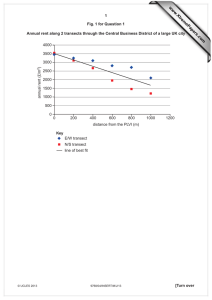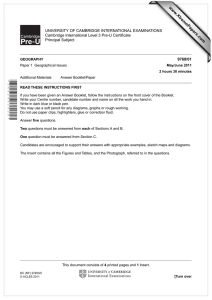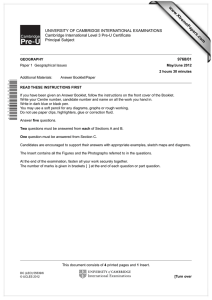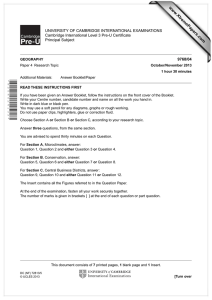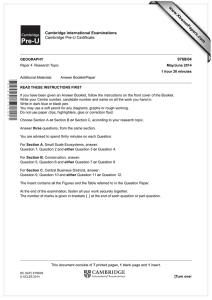www.XtremePapers.com Cambridge International Examinations 9768/01 Cambridge Pre-U Certificate
advertisement
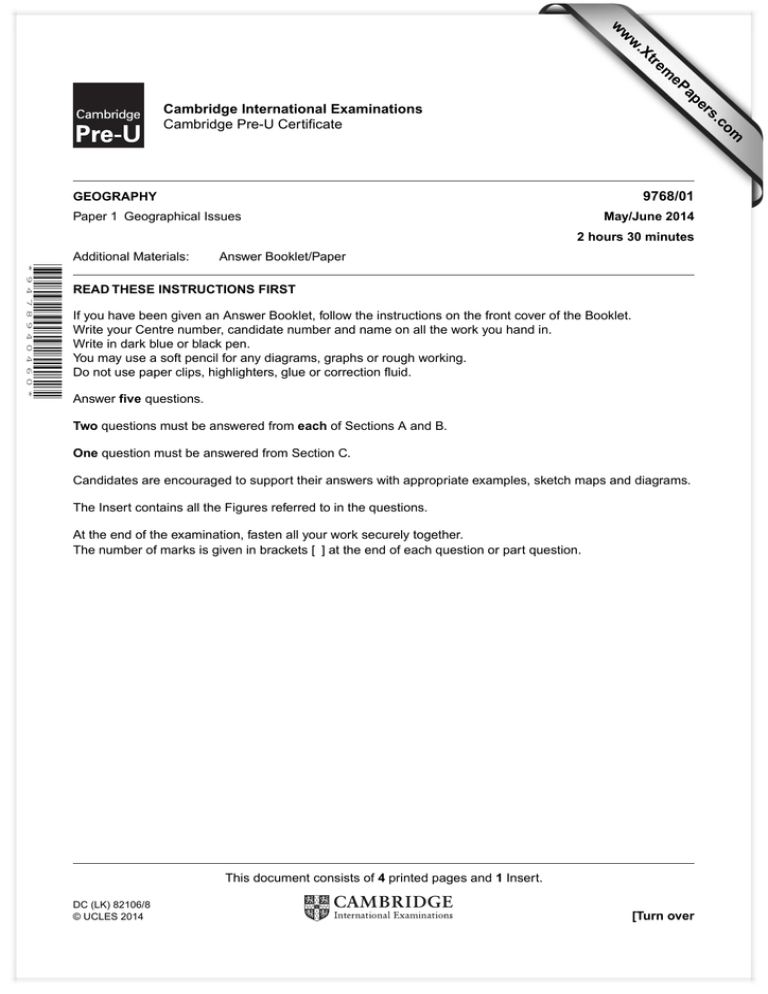
w w ap eP m e tr .X w om .c s er Cambridge International Examinations Cambridge Pre-U Certificate 9768/01 GEOGRAPHY Paper 1 Geographical Issues May/June 2014 2 hours 30 minutes Additional Materials: Answer Booklet/Paper * 9 4 7 8 9 4 0 4 6 0 * READ THESE INSTRUCTIONS FIRST If you have been given an Answer Booklet, follow the instructions on the front cover of the Booklet. Write your Centre number, candidate number and name on all the work you hand in. Write in dark blue or black pen. You may use a soft pencil for any diagrams, graphs or rough working. Do not use paper clips, highlighters, glue or correction fluid. Answer five questions. Two questions must be answered from each of Sections A and B. One question must be answered from Section C. Candidates are encouraged to support their answers with appropriate examples, sketch maps and diagrams. The Insert contains all the Figures referred to in the questions. At the end of the examination, fasten all your work securely together. The number of marks is given in brackets [ ] at the end of each question or part question. This document consists of 4 printed pages and 1 Insert. DC (LK) 82106/8 © UCLES 2014 [Turn over 2 Section A Answer two questions from this section. Tectonic Hazards 1 (a) Define the term volcanic hot spot. [2] (b) Fig. 1 shows the global distribution of volcanic hot spots, the major tectonic plates and types of plate boundaries. Describe the relationship between volcanic hot spots, plates and plate boundaries shown on Fig. 1. [4] (c) Explain, with the aid of a diagram, the formation of the volcanic islands of Hawaii. [5] (d) Discuss the extent to which volcanic hazards can be managed by effective planning during and after the event. [9] Hazardous Weather 2 (a) Name one primary and one secondary hazard associated with tropical cyclones. [2] (b) Figs 2A and 2B show the frequency of severe and non-severe tropical cyclones in Australia for the period 1970–2005. Describe the frequency of severe and non-severe tropical cyclones shown in Figs 2A and 2B. [4] (c) Explain why fewer than 10% of tropical storms become hurricanes. [5] (d) Assess the extent to which the impacts of one type of hazardous weather can be managed successfully. [9] Hydrological Hazards 3 (a) Define the term throughflow. [2] (b) Fig. 3 shows the extent of flooding in Carlisle, England, in January 2005. Describe the pattern of flooding shown on Fig. 3. [4] (c) Explain how soft engineering solutions can reduce river flooding. [5] (d) Assess the short and long term impacts of river flooding. [9] © UCLES 2014 9768/01/M/J/14 3 Section B Answer two questions from this section. The Geography of Crime 4 (a) Define the term environmental crime. [2] (b) Fig. 4 shows the total volume of oil spills by spill size in the USA for the period 1973 to 2004. Describe the pattern of volume of oil spills above and below one million gallons, shown in Fig. 4. [4] (c) Explain why the incidence of anti-social crime might be increasing. [5] (d) Assess how the characteristics of the physical and built environment might promote vulnerability to crime. [9] Health and Disease 5 (a) Define the term attack rate in relation to health and disease. [2] (b) Fig. 5 shows the global distribution of deaths from vector borne diseases for a year. Describe the global pattern shown in Fig. 5. [4] (c) With reference to two named diseases, explain how they spread. [5] (d) Assess the social and economic impacts of disease on countries at lower levels of development. [9] Spatial Inequality and Poverty 6 (a) Name two indicators that might be included in an overall measure of deprivation. [2] (b) Fig. 6 shows the relationships between level of deprivation and mode of travel to school. Describe the nature of the relationships shown in Fig. 6. [4] (c) Explain how political influences can affect levels of poverty and inequality at a regional scale. [5] (d) Examine the factors that may lead to the emergence of areas of multiple deprivation at a local scale. [9] © UCLES 2014 9768/01/M/J/14 [Turn over 4 Section C Answer one question from this section. 7 Geographical hazards are easy to identify but the risks they pose are more difficult to assess. How far do you agree with this statement? [25] 8 Discuss the view that human activity is making the world a more dangerous place. 9 To what extent is government action the most important way of managing the geographical issues present in an area you have studied? [25] [25] Copyright Acknowledgements: Question 1 Fig. 1 Question 2 Figs 2A & 2B Question 3 Fig. 3 Question 4 Fig. 4 Question 5 Fig. 5 Question 6 Fig. 6 © http://serc.carleton.edu/details/images/7761.html © http://www.bom.gov.au/cyclone/climatology/trends.shtml © http://event.concepglobal.com/accounts/register123/concep/clientaccount/flood_map_alt(1).jpg © www.safewater.org © WHO 2005; WHO World Health Report 2004; http://www.who.int/heli/risks/vectors/en/vbdmap.pdf © http://www.steerdaviesgleave.com/news-and-insights/Deprivation-as-an-indicator-for-travelling-to-school-trends Permission to reproduce items where third-party owned material protected by copyright is included has been sought and cleared where possible. Every reasonable effort has been made by the publisher (UCLES) to trace copyright holders, but if any items requiring clearance have unwittingly been included, the publisher will be pleased to make amends at the earliest possible opportunity. Cambridge International Examinations is part of the Cambridge Assessment Group. Cambridge Assessment is the brand name of University of Cambridge Local Examinations Syndicate (UCLES), which is itself a department of the University of Cambridge. © UCLES 2014 9768/01/M/J/14



